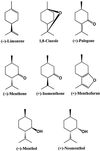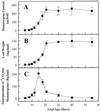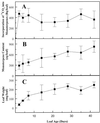Regulation of monoterpene accumulation in leaves of peppermint
- PMID: 10631264
- PMCID: PMC58859
- DOI: 10.1104/pp.122.1.205
Regulation of monoterpene accumulation in leaves of peppermint
Abstract
Plants synthesize numerous classes of natural products that accumulate during development and are thought to function as constitutive defenses against herbivores and pathogens. However, little information is available about how the levels of such defenses are regulated. We measured the accumulation of monoterpenes, a model group of constitutive defenses, in peppermint (Mentha x piperita L.) leaves and investigated several physiological processes that could regulate their accumulation: the rate of biosynthesis, the rate of metabolic loss, and the rate of volatilization. Monoterpene accumulation was found to be restricted to leaves of 12 to 20 d of age, the period of maximal leaf expansion. The rate of monoterpene biosynthesis determined by (14)CO(2) incorporation was closely correlated with monoterpene accumulation, as determined by gas chromatographic analysis, and appeared to be the principal factor controlling the monoterpene level of peppermint leaves. No significant catabolic losses of monoterpenes were detected throughout leaf development, and monoterpene volatilization was found to occur at a very low rate, which, on a monthly basis, represented less than 1% of the total pool of stored monoterpenes. The composition of volatilized monoterpenes differed significantly from that of the total plant monoterpene pool, suggesting that these volatilized products may arise from a separate secretory system. With the demonstration that the rate of biosynthesis is the chief process that determines monoterpene accumulation in peppermint, efforts to improve production in this species can now focus on the genes, enzymes, and cell differentiation processes that regulate monoterpene biosynthesis.
Figures




Similar articles
-
Developmental regulation of monoterpene biosynthesis in the glandular trichomes of peppermint.Plant Physiol. 2000 Jan;122(1):215-24. doi: 10.1104/pp.122.1.215. Plant Physiol. 2000. PMID: 10631265 Free PMC article.
-
Distribution of peltate glandular trichomes on developing leaves of peppermint.Plant Physiol. 2000 Oct;124(2):655-64. doi: 10.1104/pp.124.2.655. Plant Physiol. 2000. PMID: 11027715 Free PMC article.
-
Different stereoselectivity in the reduction of pulegone by Mentha species.Planta Med. 2001 Apr;67(3):260-2. doi: 10.1055/s-2001-11992. Planta Med. 2001. PMID: 11345699
-
Final report on the safety assessment of Mentha Piperita (Peppermint) Oil, Mentha Piperita (Peppermint) Leaf Extract, Mentha Piperita (Peppermint) Leaf, and Mentha Piperita (Peppermint) Leaf Water.Int J Toxicol. 2001;20 Suppl 3:61-73. Int J Toxicol. 2001. PMID: 11766133 Review.
-
Strategies for transgenic manipulation of monoterpene biosynthesis in plants.Trends Plant Sci. 2002 Aug;7(8):366-73. doi: 10.1016/s1360-1385(02)02303-8. Trends Plant Sci. 2002. PMID: 12167332 Review.
Cited by
-
Lavender inflorescence: a model to study regulation of terpenes synthesis.Plant Signal Behav. 2010 Jun;5(6):749-51. doi: 10.4161/psb.5.6.11704. Epub 2010 Jun 1. Plant Signal Behav. 2010. PMID: 20418661 Free PMC article.
-
Productivity and quality of volatile oil extracted from Mentha spicata and M. arvensis var. piperascens grown by a hydroponic system using the deep flow technique.J Nat Med. 2010 Jan;64(1):31-5. doi: 10.1007/s11418-009-0361-5. Epub 2009 Sep 18. J Nat Med. 2010. PMID: 19763744
-
sCentInDB: a database of essential oil chemical profiles of Indian medicinal plants.Mol Divers. 2025 May 9. doi: 10.1007/s11030-025-11215-5. Online ahead of print. Mol Divers. 2025. PMID: 40343630
-
Cloning, functional characterization and genomic organization of 1,8-cineole synthases from Lavandula.Plant Mol Biol. 2012 Jul;79(4-5):393-411. doi: 10.1007/s11103-012-9920-3. Epub 2012 May 17. Plant Mol Biol. 2012. PMID: 22592779
-
Development of peltate glandular trichomes of peppermint.Plant Physiol. 2000 Oct;124(2):665-80. doi: 10.1104/pp.124.2.665. Plant Physiol. 2000. PMID: 11027716 Free PMC article.
References
-
- Alonso WR, Rajaonarivony JIM, Gershenzon J, Croteau R. Purification of 4S-limonene synthase, a monoterpene cyclase from the glandular trichomes of peppermint (Mentha × piperita) and spearmint (Mentha spicata) J Biol Chem. 1992;267:7582–7587. - PubMed
-
- Amelunxen F. Elektronenmikroskopische Untersuchungen an den Drüsenschuppen von Mentha piperita L. Planta Med. 1965;13:457–473.
-
- Bernard-Dagan C, Pauly G, Marpeau A, Gleizes M, Carde J-P, Baradat P. Control and compartmentation of terpene biosynthesis in leaves of Pinus pinaster. Physiol Veg. 1982;20:775–795.
Publication types
MeSH terms
Substances
LinkOut - more resources
Full Text Sources

